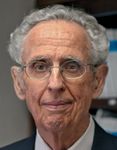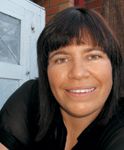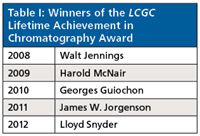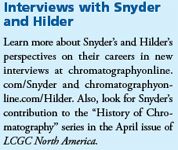The 2012 LCGC Awards
The results are in for 2012 LCGC Awards, and we are proud to announce the winners: the Lifetime Achievement in Chromatography Award is granted to Lloyd Snyder, and the Emerging Leader in Chromatography Award is presented to Emily Hilder. In achieving this honor, they join a group of illustrious past winners (Tables I and II).
The results are in for 2012 LCGC Awards, and we are proud to announce the winners: the Lifetime Achievement in Chromatography Award is granted to Lloyd Snyder, and the Emerging Leader in Chromatography Award is presented to Emily Hilder. In achieving this honor, they join a group of illustrious past winners (Tables I and II).

Lloyd Snyder
Lloyd Snyder
Lloyd Snyder's contributions to the field of chromatography are so many and so broad that it's very difficult to summarize them in just a few sentences. Snyder is known not only for his many important contributions to an understanding of high performance liquid chromatography (HPLC), but also for his teaching, mentoring, and acclaimed publications.

Emily Hilder
"I would challenge anyone to name an area of chromatography where Lloyd has not made a seminal contribution," said John G. Dorsey, Katherine Blood Hoffman Professor in the Department of Chemistry and Biochemistry at Florida State University (Tallahassee, Florida) and the editor of the Journal of Chromatography A.

Table I: Winners of the LCGC Lifetime Achievement in Chromatography Award
A Career in Industry
After receiving his PhD in organic chemistry in 1954 from the University of California at Berkeley, Snyder spent his entire career in industry. He began at Shell Oil in Houston, Texas, where he initially encountered chromatography at first hand. In 1957 he moved to Union Oil in Brea, California, where his research resulted in numerous procedures for the compositional analysis of petroleum, as well as a comprehensive understanding of adsorption chromatography. In 1971 he moved to the Technicon Instruments Corporation, first serving as VP of Research and later VP of Clinical Chemistry. Despite his administrative duties, Snyder found time for an HPLC research program and the development of the linear-solvent-strength model of gradient elution.

Table II: Winners of the LCGC Emerging Leader in Chromatography Award
It was also at Technicon that Lloyd began his lifetime association with Jack Kirkland (who was then at DuPont), a collaboration that resulted in dozens of scientific papers and four books, including all three editions of the perennial best seller of separation science, Introduction to Modern Liquid Chromatography, the second edition of which sold more than 20,000 copies. From 1971 to 1995, Kirkland and Snyder teamed up with the American Chemical Society to teach short courses, first on basic LC and later on method development.
After leaving Technicon, Lloyd started a private consulting business, which provided chromatographic expertise to various clients, especially DuPont. In 1984, he and John Dolan started LC Resources, Inc., in Walnut Creek, California, to be joined a few years later by Tom Jupille. By then, Snyder and Dolan had already known each other for many years. They first met in 1977 when Dolan was a postdoctoral researcher in Barry Karger's laboratory at Northeastern University in Boston and Technicon was supporting the research Dolan was working on. Snyder had subsequently hired Dolan at Technicon. Snyder, Dolan, and Jupille continue to work together at LC Resources today, although Snyder claims to have retired at the end of 2011. It is his third attempt at retirement.
Advancing HPLC Theory and Practice
During all those years in industry, Lloyd kept his research activities alive with countless collaborative projects, and his work enabled invaluable advances in the science of chromatography. "I can state without exaggeration that Lloyd has been one of the very few chromatographers who can be credited with both a significant contribution to the theory of LC and the transfer of that information into practice," says Dolan.
Pete Carr, a chemistry professor at the University of Minnesota in Minneapolis and one of Snyder's long-time collaborators, put it more simply. "In my opinion, Lloyd Snyder belongs on the Mount Rushmore of chromatography," he said.
In particular, collaborators and admirers (and all of his collaborators seem to become admirers), laud Snyder's ability to distill complex relationships into simple models. "Lloyd has a unique ability to fit bits and pieces of disparate research together and fill in the gaps," says Dolan. "He builds simplified explanations of otherwise confusing processes."
One of Snyder's major contributions to the field was the development of the "solvent-selectivity triangle," a concept Snyder used to explain the role of solvent selectivity in which he classified solvents according to their hydrogen-bond acidic, basic, and dipolar nature. The application of this work to reversed-phase LC led to an understanding of why methanol, acetonitrile, and tetrahydrofuran are the key solvents for use in reversed-phase LC. The article explaining this concept (1) was published in 1974 and has been cited more than 500 times.
Snyder also made important contributions to the understanding of adsorption chromatography. An outgrowth of his work in the petroleum industry, Snyder's understanding of normal-phase chromatography led to the classification of solvent strength, a better understanding of the mechanism of adsorption chromatography, and his first book, Principles of Adsorption Chromatography (Marcel Dekker, 1968). This work, and particularly its applications to the field of preparative separations (many of which are done using adsorption techniques), still contributes to the field of separations more than 40 years later.
Snyder's ability to distill complex relationships into simple models was again shown in his work in gradient elution. His publication in 1979 (2) demystified gradient elution and has been cited more than 500 times. Years of research on various aspects of gradient elution are summarized in his 2007 book, High Performance Gradient Elution (Wiley), coauthored with Dolan.
Another example of Snyder's ability to build simplified explanations of confusing processes is highlighted in his work developing computer simulation for HPLC, combining the power of the personal computer with mathematical models and limited experimental data to accurately predict the outcome of other experiments. The DryLab software that he pioneered in the mid-1980s allows chromatographers to find optimum separation conditions in half a day instead of days or weeks of laboratory work. Models now exist for isocratic, gradient, ion-exchange, ion-pairing, temperature, and normal-phase separations, alone or as a combination of up to three variables changed simultaneously. Experts say this work revolutionized HPLC method development, saving countless thousands of hours of laboratory work. "The results of this work also greatly expanded the utility of liquid chromatography to many laboratories in a wide variety of fields of chemistry," said Joe Glajch, another Snyder collaborator, who now works for Momenta Pharmaceuticals in Cambridge, Massachusetts.
Snyder's more recent contributions have focused on gaining a better understanding of reversed-phase retention. The hydrophobic-subtraction model he developed uses quantitative relationships among five key interactions that allow the comparison of the similarity (equivalency) or dissimilarity (orthogonality) of reversed-phase columns (3). A practical result of Snyder's work is the availability of a free database on the United States Pharmacopeia web site (4) that allows chromatographers to compare more than 500 commercial columns to help select equivalent or orthogonal columns.
Carr sums up Snyder's technical contributions. "He has contributed to our understanding of liquid-state interactions in chromatography, to gradient elution, to method development and optimization, to overload chromatography, the dynamics of peak broadening, and most recently to stationary-phase selectivity."
"Lloyd has incredible insight into what makes chromatography work at a molecular level," adds Carr. "I can truly say that much of what I know of chromatography in principle and practice I learned through his work."
Important Publications
All of Snyder's scientific developments led to extensive publishing, which is unusual for a scientist working in industry, where publishing is often seen as an extra activity that must be done in one's free time. As of this writing, Snyder has published about 300 scientific papers and nine books (see sidebar), at least three of which are considered seminal works that had an enormous impact on the practice of chromatography. "Although two of the books are in multiple editions, each has been rewritten from cover to cover," says Dolan.

Books by Lloyd Snyder
The best known of his books is Introduction to Modern Liquid Chromatography (now in its third edition). Some estimate that more than 50,000 scientists received important training in chromatography through his very practically oriented books.
Snyder's involvement in publishing was not limited to his role as an author, however. He has served on the editorial board of the Journal of Chromatography A since 1971 and was an editor from 1987 to 2000. He also served on the editorial board of LCGC North America since the magazine's inception in 1983, stepping down only last year.
Teaching and Mentoring
In spite of Snyder's pivotal advances of the theory and practice of HPLC, many feel his most important contribution was his teaching and mentoring of thousands of people over the years. The short courses that Snyder and Kirkland taught on basic LC and method development were the most popular of all of the ACS courses for many years. Many believe these short courses were an important reason that HPLC expanded to so many laboratories throughout the world. By the time Snyder stepped down from his ACS teaching and related courses offered by LC Resources, he had actively trained more than 10,000 practicing chromatographers — no small number for someone who never held an academic post.
Snyder also mentored countless scientists. Dorsey of Florida State University says that Snyder mentored him years ago, and now mentors Dorsey's students. "Over the past year, Lloyd has had e-mail exchanges about the intricacies of the hydrophobic-subtraction model of retention with at least two of my graduate students," Dorsey says. "They are awed that he responds to them, but I would have been stunned had he not. He is driven both by a need to teach, and by a scientific curiosity about chromatography. He has served as an inspiration to more scientists than he will ever know."
"Lloyd was a patient teacher and always willing to explain to those new to the field some difficult concepts in a way that anyone could understand," adds Glajch.
And Snyder's teaching and mentoring is not limited to the field of chromatography. Today, Snyder volunteers once a week at a homeless shelter where he works with men in recovery, teaching them basic academic skills.
A Generous Collaborator
Praise for Snyder is not limited to his scientific contributions. The eight prominent chromatographers who submitted letters supporting Snyder's nomination for the Lifetime Achievement award all cited Snyder's friendship, generous nature, and ability to foster and sustain scientific collaboration.

Interviews with Snyder and Hilder
"I consider him to be a close friend from whom I have learned much not just scientifically but how to do science, and more importantly, how to deal with people," says Carr.
All of Snyder's collaborators say they received more than they contributed when working with him. Carr dubbed this the Snyder Non-Conservation Principle: "On a paper with five coauthors, everyone gets one third of the credit," he explains.
Dorsey agrees. "I followed Lloyd as Editor for Journal of Chromatography A (please note I did not say I "replaced" him) and I watched the outpouring of respect and appreciation from authors, reviewers, employees of Elsevier, and everyone who came in contact with him in that role," he said.
Everyone seems to agree that Snyder's character is equal to his intelligence. Jack Kirkland sums up these sentiments. "With all of his many landmark scientific achievements, Lloyd continues as a humble man, eager to help both in the scientific world and in everyday life," says Kirkland. "He is a true friend and an outstanding scientist."
Emily Hilder
Like our 2012 Lifetime Achievement Award laureate, the winner of the 2012 LCGC Emerging Leader in Chromatography Award, Emily Hilder, is also a scientist with a broad range of interests. Still in the early stages of her career, Hilder has already developed a broad scope of demonstrated expert knowledge, ranging from chromatography to electrophoresis and from column materials to instrumentation, miniaturized devices, and theoretical concepts. She has applied this knowledge in many areas, including the life sciences, environmental, and forensic applications.
"In a time in which many scientists focus on very small areas this is a refreshing approach," says Peter Schoenmakers, professor of analytical chemistry in the Van 't Hoff Institute for Molecular Sciences at the University of Amsterdam (The Netherlands).
Hilder received her PhD in analytical chemistry from the University of Tasmania (Tasmania, Australia) in 2001, studying under Paul Haddad, and she is already a full professor in the School of Chemistry and Australian Centre in Research on Separation Science (ACROSS) at the University of Tasmania. Hilder's most noted achievements in her career to date have been in the design and synthesis of porous polymeric materials for applications in chromatography and sample preparation, work she began as a postdoctoral researcher at E.O. Lawrence Berkeley National Laboratory, in Berkeley, California, working under Frank Svec. She has published more than 28 papers in this area, including six major reviews (5–10), and has spoken on this topic at numerous international conferences. She has developed new strategies for selective functionalization of monolithic materials, in particular using UV light (11) and nanoparticles (12), some of which have been are commercialized. The impact of her work in this area is evidenced by her strong links with industrial partners, including Dionex (now part of Thermo Fisher Scientific), which has developed new monolithic separation media based on her research.
More recently, Hilder has developed thin-layer monoliths for dried-blood spot analysis (13), which she dubbed "MilliSpot." This technology has widespread application in the pharmaceutical industry and offers substantial advantages over existing paper-based media. The work has resulted in two patent applications (14,15), and there is intense commercial interest in this technology.
Another important focus of Hilder's work has been ion analysis, in particular the combination of chromatographic and electrophoretic separation mechanisms to achieve unique selectivity for ionic analytes in capillary electrochromatography (CEC). She was the first to demonstrate the mixed-mode separation of inorganic anions by CEC (16), including introduction of a mathematical model to describe the separation mechanism (17). In subsequent work she introduced the concept of a voltage gradient for selectivity control in CEC (18) and was the first to demonstrate capacitively coupled contactless conductivity detection as a new method of detection in CEC, with detection achieved through the packed bed (19). Using the same general approach for mixed-mode CEC, she demonstrated the simultaneous separation of acidic, basic, and neutral small molecules (20) and later extended this approach to the separation of a range of biomolecules by CEC (21).
An important example of a practical application of Hilder's expertise has been the development of new ion chromatography and capillary electrophoresis methods for the identification of improvised explosive devices, both pre- and post-blast (22–27). Following the 2002 Bali nightclub bombing, which killed more than 200 people, including more than 80 Australians, the Australian federal police approached an ACROSS team, including Hilder, because of their expertise in the separation of inorganic ions. Based on the results of that work (28), Emergency Management Australia purchased eight new ion chromatographs in 2007 to enable each of Australia's major laboratories to implement these methods in the field. It has also led to the development of prototype miniaturized CE-based instruments that may be developed into commercialized instruments and that can be taken if not into the field, at least close to the field, such as in a nearby hotel room.
Hilder also was instrumental in the development of an analytical method that was identified by the U.S. Food and Drug Administration (FDA) in 2008 as one of the only methods suitable for screening heparin for potentially lethal impurities. (29). The FDA subsequently required that all heparin be screened using this method, and this provided the impetus for the development of more advanced methods for heparin screening.
Hilder has 84 publications to her credit, including two edited journal special issues, two book chapters, 68 journal articles, three patent applications, and nine other publications. She has given more than 126 presentations at national and international scientific meetings, including 22 invited plenary and keynote lectures and over 108 contributed papers. Her publications have had over 1500 career citations, and her h-index (Scopus) is 23.
She was an Australian Research Council (ARC) Postdoctoral Fellow at the University of Tasmania from 2004 to 2007 and is currently an ARC Future Fellow (2009–2013), research fellowships that recognize exceptional early- and mid-career researchers, respectively.
Hilder is currently an editor of the Journal of Separation Science, and was formerly a member of the editorial advisory board of that journal. She has also served as the guest editor of a volume of the Journal of Chromatography (30). She also acts as a referee for more than 10 international journals in analytical and materials chemistry. She was recognized independently by the editors of three journals, Journal of Chromatography A, Journal of Pharmaceutical and Biomedical Analysis, and Analytica Chimica Acta, as a "Top Reviewer" in 2006, 2007, 2008, and 2009.
Looking to the future, another important problem in analytical chemistry that Hilder wants to tackle is one that many find too tedious or too overwhelming — sample preparation.
References
(1) L.R. Snyder, J. Chromatogr. A 92(2), 223–230 (1974).
(2) L.R. Snyder, J.W. Dolan, and J.R. Gant, J. Chromatogr. A 165(1), 3–30 (1979).
(3) L.R. Snyder, J.W. Dolan, D.H. Marchand, and P.W. Carr, Adv. Chromatogr. 50, (2012) in press.
(4) United States Pharmacopeia, Column Equivalency Application, available at http://www.usp.org/app/USPNF/columns.html.
(5) E.F. Hilder, F. Svec, and J.M.J. Fréchet, Electrophoresis 23, 3934–3953 (2002).
(6) E.F. Hilder, F. Svec, and J.M.J. Fréchet, J. Chromatogr. A 1044, 3–22 (2004).
(7) D. Schaller, E.F. Hilder, and P.R. Haddad, J. Sep. Sci. 29, 1705–1719 (2006).
(8) O.G. Potter and E.F. Hilder, J. Sep. Sci. 31, 1881–1906 (2008).
(9) A. Nordborg and E.F. Hilder, Anal. Bioanal. Chem. 394, 71–84 (2009).
(10) K.C. Saunders and A. Ghanem, Anal. Chim. Acta 652, 22–31 (2009).
(11) T. Rohr, E.F. Hilder, J.J. Donovan, F. Svec, and J.M.J. Fréchet, Macromolecules 36, 1677–1684 (2003).
(12) E.F. Hilder, F. Svec, and J.M.J. Fréchet, J. Chromatogr. A 1053, 101–106 (2004).
(13) E.F. Hilder, Aust. J. Chem. 64, 843 (2011).
(14) E.F. Hilder, P.R. Haddad, E. Candish, and M. Bayliss, Patent application PCT/AU2011/000008, filed on 11 January 2011.
(15) E.F. Hilder, Australian provisional patent application filed on 12 July 2011.
(16) E.F. Hilder, M. Macka, and P.R. Haddad, Anal. Commun. 36, 299–303 (1999).
(17) M.C. Breadmore, E.F. Hilder, M. Macka, N. Avdalovic, and P.R. Haddad, Electrophoresis 22, 503–510 (2001).
(18) E.F. Hilder, C.W. Klampfl, and P.R. Haddad, J. Chromatogr. A 890, 337–345 (2000).
(19) E.F. Hilder, A.J. Zemann, M. Macka, and P.R. Haddad, Electrophoresis 22, 1273–1281 (2001).
(20) C.W. Klampfl, E.F. Hilder, and P.R. Haddad, J. Chromatogr. A 888, 267–274 (2000).
(21) E.F. Hilder, F. Svec, and J.M.J. Fréchet, Anal. Chem. 76, 3887–3892 (2004).
(22) J.P. Hutchinson, C.J. Evenhuis, C. Johns, A.A. Kazarian, M.C. Breadmore, M. Macka, E.F. Hilder, R.M. Guijt, G.W. Dicinoski, and P.R. Haddad, Anal. Chem. 79, 7005–7013 (2007).
(23) C. Johns, R.A. Shellie, O.G. Potter, J.W. O'Reilly, J.P. Hutchinson, R.M. Guijt, M.C. Breadmore, E.F. Hilder, G.W. Dicinoski, and P.R Haddad, J. Chromatogr. A 1182, 205–214 (2008).
(24) O.G. Potter and E.F. Hilder, J. Sep. Sci. 31, 1881–1906 (2008).
(25) J.P. Hutchinson, C. Johns, M.C. Breadmore, E.F. Hilder, R.M. Guijt, C. Lennard, G. Dicinoski, and P.R. Haddad, Electrophoresis 29, 4593–4602 (2008).
(26) É. Tyrrell, G.W. Dicinoski, E.F. Hilder, R.A. Shellie, M.C. Breadmore, C.A. Pohl, and P.R. Haddad, J. Chromatogr. A 1218, 3007–3012 (2011).
(27) G. Blanco, Y.H. Nai, E.F. Hilder, R.A. Shellie, G.W. Dicinoski, P.R. Haddad, and M.C. Breadmore, Anal. Chem. DOI: 10.1021/ac2020195 (2011).
(28) J.P. Hutchinson, C.J. Evenhuis, C. Johns, A.A. Kazarian, M.C. Breadmore, M. Macka, E.F. Hilder, R.M. Guijt, G.W. Dicinoski, and P.R. Haddad, Anal. Chem. 79, 7005–7013 (2007).
(29) R.P. Patel, C. Narkowicz, J.P. Hutchinson, E.F. Hilder, and G.A. Jacobson, J. Pharm. Biomed. Anal. 46, 30–35 (2008).
(30) J.Chromatogr. A 1213(1), (2008).
Regulatory Deadlines and Supply Chain Challenges Take Center Stage in Nitrosamine Discussion
April 10th 2025During an LCGC International peer exchange, Aloka Srinivasan, Mayank Bhanti, and Amber Burch discussed the regulatory deadlines and supply chain challenges that come with nitrosamine analysis.






